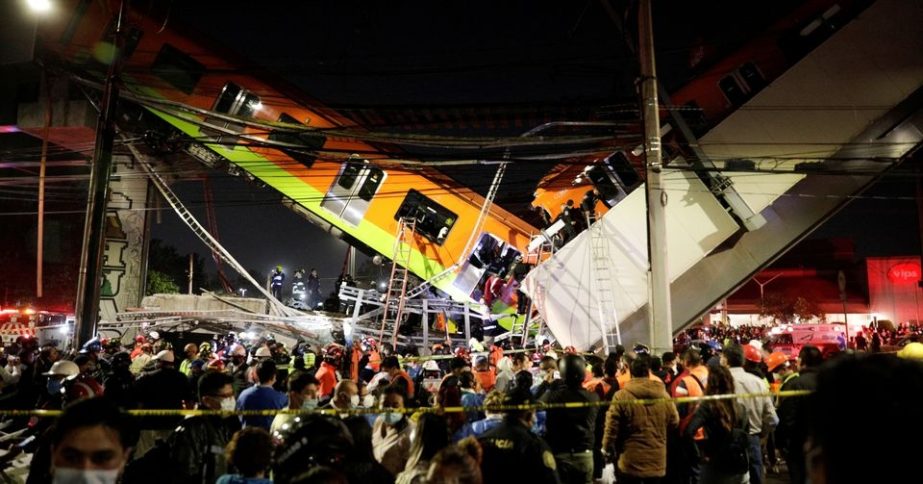
AP, Maxico :
An elevated section of the Mexico City metro collapsed and sent a subway car plunging toward a busy boulevard late Monday, killing at least 23 people and injuring about 70, city officials said.
A crane was working to hold up one subway car left dangling on the collapsed section so that emergency workers could enter to check the car to see if anyone was still trapped. Mayor Claudia Sheinbaum said 49 of the injured were hospitalized, and that seven were in serious condition and undergoing surgery.
Sheinbaum said a motorist had been pulled alive from a car that was trapped on the roadway below. Dozens of rescuers continued searching through wreckage from the collapsed, preformed concrete structure.
“There are unfortunately children among the dead,” Sheinbaum said, without specifying how many. ,
The overpass was about 5 meters above the road in the southside borough of Tlahuac, but the train ran above a concrete median strip, which apparently lessened the casualties among motorists on the roadway below.
“A support beam gave way,” Sheinbaum said, adding that the beam collapsed just as the train passed over it.
Rescue efforts were briefly interrupted at midnight because the partially dangling train was “very weak.”
“We don’t know if they are alive,” Sheinbaum said of the people possibly trapped inside the subway car.
Hundreds of police officers and firefighters cordoned off the scene as desperate friends and relatives of people believed to be on the trains gathered outside the security perimeter.

Oscar López, 26, was searching for his friend, Adriana Salas, 26. Six months pregnant, she was riding the subway home from her work as a dentist when her phone stopped answering around the time the accident occurred.
“We lost contact with her, at 10:50 p.m., there was literally no more contact,” López said. With little information and a still serious coronavirus situation in Mexico City, López said “they are not telling us anything, and people are just crowding together.”
The collapse occurred on the newest of the Mexico City subway’s lines, Line 12, which stretches far into the city’s southside. Like many of the city’s dozen subway lines, it runs underground through more central areas of the city of 9 million, but then runs on elevated, pre-formed concrete structures on the city’s outskirts.
The collapse could represent a major blow for Mexican Foreign Relations Secretary Marcelo Ebrard, who was Mexico City’s mayor from 2006 to 2012, when Line 12 was built. Allegations about poor design and construction on the subway line emerged soon after Ebrard left office as mayor. The line had to be partly closed in 2013 so tracks could be repaired.
Ebrard wrote on Twitter: “What happened today on the Metro is a terrible tragedy.”
“Of course, the causes should be investigated and those responsible should be identified,” he wrote. “I repeat that I am entirely at the disposition of authorities to contribute in whatever way is necessary.”
It was not clear whether a 7.1-magnitude earthquake in 2017 could have affected the subway line.
The Mexico City Metro, one of the largest and busiest in the world, has had at least two serious accidents since its inauguration half a century ago.
In March of last year, a collision between two trains at the Tacubaya station left one passenger dead and injured 41 people. In 2015, a train that did not stop on time crashed into another at the Oceania station, injuring 12 people.

